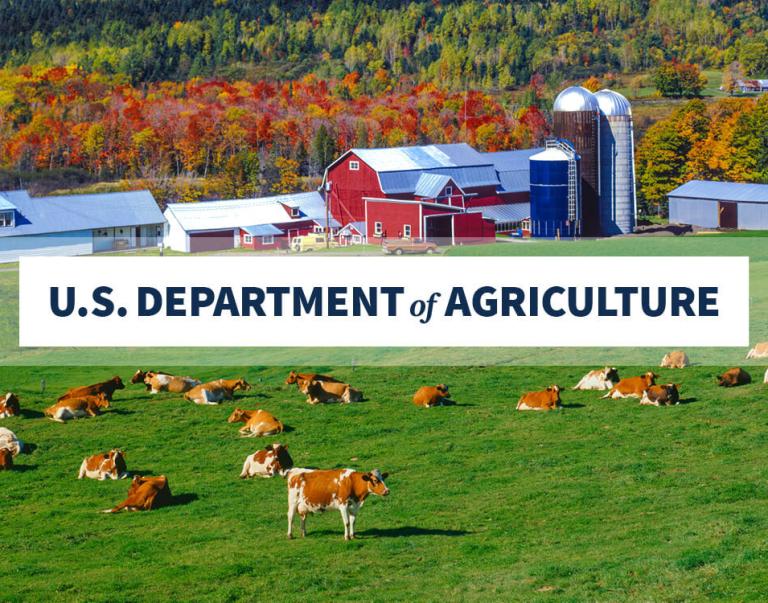Sustainability
Sustainable agricultural productivity growth is a foundational element in building more sustainable agricultural and food systems.
Sustainable agricultural productivity growth is a foundational element in building more sustainable agricultural and food systems. Without it, our ability to meet current and future food needs, conserve natural resources, and support the long-term viability of agriculture is endangered.
The U.S. Department of Agriculture is committed to working with partners and stakeholders toward the sustainability of diverse agricultural and food systems, where the sustainability of a system is judged by its success in advancing objectives related to the social, economic, and environmental dimensions of sustainability. These objectives include providing safe and nutritious food for all; providing decent incomes and wages for farmers and those working across the system; and conserving natural resources for the benefit of current and future populations.
At USDA, the advancement of more sustainable agricultural and food systems, including through sustainable productivity growth, is supported by holistic, science-based, data-driven decision-making and innovative solutions. Critical elements of this approach include:
- Science [English (PDF, 667 KB) (PDF, 667 KB) | Spanish (PDF, 668 KB) (PDF, 668 KB) | French (PDF, 667 KB) (PDF, 667 KB) | Portuguese (PDF, 671 KB) (PDF, 671 KB) | Italian (PDF, 680 KB) (PDF, 680 KB) | Arabic (PDF, 830 KB) (PDF, 830 KB)]
- Innovation [English (PDF, 550 KB) (PDF, 550 KB) | Spanish (PDF, 591 KB) (PDF, 591 KB) | French (PDF, 575 KB) (PDF, 575 KB) | Portuguese (PDF, 554 KB) (PDF, 554 KB) | Italian (PDF, 509 KB) (PDF, 509 KB) | Arabic (PDF, 575 KB) (PDF, 575 KB)]
- Place-based solutions [English (PDF, 781 KB) (PDF, 781 KB) | Spanish (PDF, 726 KB) (PDF, 726 KB) | French (PDF, 780 KB) (PDF, 780 KB) | Portuguese (PDF, 716 KB) (PDF, 716 KB) | Italian (PDF, 666 KB) (PDF, 666 KB) | Arabic (PDF, 854 KB) (PDF, 854 KB)]
- Systems approaches [English (PDF, 448 KB) (PDF, 448 KB) | Spanish (PDF, 463 KB) (PDF, 463 KB) | French (PDF, 464 KB) (PDF, 464 KB) | Portuguese (PDF, 447 KB) (PDF, 447 KB) | Italian (PDF, 469 KB) (PDF, 469 KB) | Arabic (PDF, 732 KB) (PDF, 732 KB)]
Critical Resources
USDA promotes climate-resilient landscapes and rural economic systems. USDA contributes to climate assessments, analysis of adaptation and mitigation options, cost-benefit analyses, and tools to support agriculture, forests, grazing lands, and rural communities.
Learn More
USDA recognizes that conservation by farmers, ranchers and forest owners today means thriving and sustainable agriculture for our future.
Learn More
Environmental markets can serve as a complement to traditional conservation programs. Current active and pilot markets exist for greenhouse gases, water quality, water quantity, wetlands, and habitats.
Learn More
USDA embarked on a groundbreaking analysis about the potential benefits of rural broadband infrastructure and emerging on-farm technology for modernizing the United States’ agriculture industry and all who depend on its success.
Learn More
The U.S. Department of Agriculture is committed to working with partners and stakeholders toward the sustainability of diverse agricultural and food systems, where the sustainability of a system is judged by its success in advancing objectives related to the social, economic, and environmental dimensions of sustainability.
Learn More
The Office of Energy and Environmental Policy (OEEP) is the focal point for the USDA’s energy, environmental markets, and climate change activities.
Learn More










